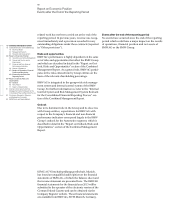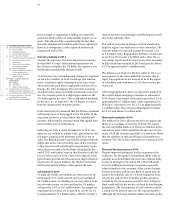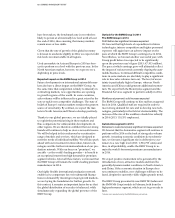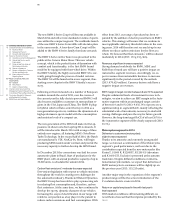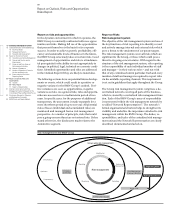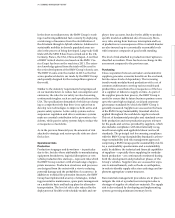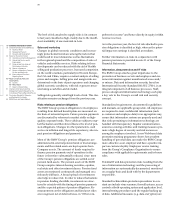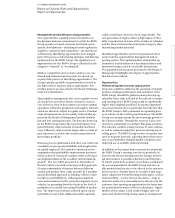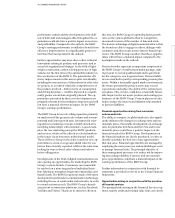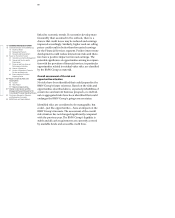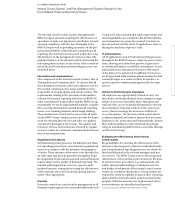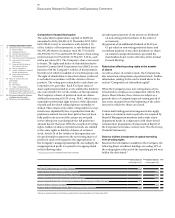BMW 2013 Annual Report Download - page 72
Download and view the complete annual report
Please find page 72 of the 2013 BMW annual report below. You can navigate through the pages in the report by either clicking on the pages listed below, or by using the keyword search tool below to find specific information within the annual report.
72
18 COMBINED MANAGEMENT REPORT
18
General Information on the BMW Group
18 Business Model
20 Management System
23 Research and Development
24 Report on Economic Position
24 Overall Assessment by Management
24 General and Sector-specific
Environment
27
Financial and Non-financial
Performance Indicators
29 Review of Operations
47 Results of Operations, Financial
Position and Net Assets
62 Events after the End of the
Reporting Period
63 Report on Outlook, Risks and
Opportunities
63 Outlook
68 Risks Report
77 Report on Opportunities
81 Internal Control System and Risk
Management System Relevant for
the
Consolidated Financial Reporting Process
82 Disclosures Relevant for Takeovers
and Explanatory Comments
85
BMW Stock and Capital Markets
The level of risk attached to supply risks is (in contrast
to last year) classified as high, mainly due to the insuffi-
cient availability of raw materials in Asia.
Sales and marketing
Changes in global economic con ditions and increas-
ingly protectionist
trends are among the factors that
could result in lower demand as well as
fluctuations
in
the regional spread and the composition of sales of
vehicles and mobility services. Risks relating to these
developments can be reduced with the
aid of flexible
selling and production processes. Increased competition
on the world’s markets, particularly in Western Europe,
the USA and China, requires constant analysis of selling
prices and margins. Selling price and margin risks are
determined on the basis of past experience and changing
global economic conditions, with risk exposures meas-
ured using a cash-flow-at-risk model.
Selling risks generally entail high levels of risk. This clas-
sification remains unchanged from the previous year.
Risks relating to pension obligations
The BMW Group’s pension obligations to its employees
resulting from
defined benefit plans are measured on
the basis of actuarial
reports. Future pension payments
are discounted
by reference to market yields on high-
quality corporate bonds. These yields are subject to mar-
ket fluctuation and therefore influence the level of
pen-
sion obligations. Changes in other parameters, such
as
rises in inflation
and longer life expectancy, also im-
pact pension obligations
and payments.
Most of the BMW Group’s pension obligations are
administered in external pension funds or trust arrange-
ments
and the related assets are kept separate from
Company assets. The amount of funds required to
finance
pension payments out of operations in the
future is therefore substantially reduced, since most
of
the Group’s pension obligations are settled out of
pension fund assets. The pension assets of the BMW
Group comprise interest-bearing securities, equities,
real estate and other investment classes. Pension fund
assets are monitored continuously and managed on a
risk-and-yield basis. A broad spread of investments
also
helps to reduce risk. In order to reduce fluctuations
in pension funding shortfalls, investments are struc-
tured to coincide with the timing of pension payments
and the expected pattern of pension obligations. Re-
measurements on the obligations and fund asset sides
are recognised, net of deferred taxes, in “Other com-
prehensive income” and hence directly in equity (within
revenue reserves).
As in the previous year, the level of risk attached to pen-
sion obligations is classified as high, whereas the poten-
tial impact on earnings is classified as medium.
Further information on risks in conjunction with
pension provisions is provided in note 31 of the Group
Finan cial Statements.
Information, data protection and IT risks
The BMW Group attaches great importance to the
protection of business secrets and employee and cus-
tomer information against unauthorised access and /
or misuse. Data and information security, based on
Inter national Security Standard ISO / IEC 27001, is an
integral component of all business processes. Staff,
process design and information technology each play
a key role in the Group’s overall risk and security
concept.
Standardised requirements, documented in guidelines
and manuals, are applicable group-wide. All employees
are required to treat confidential information (such
as customer and employee data) in an appropriate way,
ensure that information systems are properly used and
that risks pertaining to information technology are
handled with transparency. Regular
communication,
awareness-raising activities and training
measures
pro-
mote a high degree of security and risk awareness
among the employees involved. A new Web-based data
protection training programme shows how prudent
handling of personal data can make the BMW Group
more attractive as an employer and have a
positive im-
pact on customer loyalty. Employees receive training
from the Group’s Compliance Organisation to ensure
compliance with applicable requirements and in-house
rules.
Potential IT and data protection risks resulting from the
use of information technology and the processing of
information
are systematically documented, monitored
on a regular basis and dealt with by the departments
responsible.
Standard technical data protection procedures in con-
stant use include virus scanners, firewall systems, access
controls at both operating system and application level,
internal testing procedures and the regular backing up
of data. Additional measures (e. g. data encryption)
are


